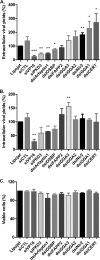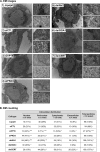Cellular Protein Kinase D Modulators Play a Role during Multiple Steps of Herpes Simplex Virus 1 Egress
- PMID: 30232182
- PMCID: PMC6232494
- DOI: 10.1128/JVI.01486-18
Cellular Protein Kinase D Modulators Play a Role during Multiple Steps of Herpes Simplex Virus 1 Egress
Abstract
The assembly of new herpes simplex virus 1 (HSV-1) particles takes place in the nucleus. These particles then travel across the two nuclear membranes and acquire a final envelope from a cellular compartment. The contribution of the cell to the release of the virus is, however, little known. We previously demonstrated, using a synchronized infection, that the host protein kinase D and diacylglycerol, a lipid that recruits the kinase to the trans-Golgi network (TGN), promote the release of the virus from that compartment. Given the role this cellular protein plays in the herpes simplex virus 1 life cycle and the many molecules that modulate its activity, we aimed to determine to what extent this virus utilizes the protein kinase D pathway during a nonsynchronized infection. Several molecular protein kinase D (PKD) regulators were targeted by RNA interference and viral production monitored. Surprisingly, many of these modulators negatively impacted the extracellular release of the virus. Overexpression studies, the use of pharmacological reagents, and assays to monitor intracellular lipids implicated in the biology of PKD suggested that these effects were oddly independent of total intracellular diacylglycerol levels. Instead, mapping of the viral intermediates by electron microscopy suggested that some of these modulators could regulate distinct steps along the viral egress pathway, notably nuclear egress. Altogether, this suggests a more complex contribution of PKD to HSV-1 egress than originally anticipated and new research avenues to explore.IMPORTANCE Viruses are obligatory parasites that highjack numerous cellular functions. This is certainly true when it comes to transporting viral particles within the cell. Herpesviruses share the unique property of traveling through the two nuclear membranes by subsequent budding and fusion and acquiring their final envelope from a cellular organelle. Albeit disputed, the overall evidence from many laboratories points to the trans-Golgi network (TGN) as the source of that membrane. Moreover, past findings revealed that the host protein kinase D (PKD) plays an important role at that stage, which is significant given the known implication of that protein in vesicular transport. The present findings suggest that the PKD machinery not only affects the late stages of herpes simplex virus I egress but also modulates earlier steps, such as nuclear egress. This opens up new means to control these viruses.
Keywords: Arf; CERT; GGA1; HSV; Nir2; PKD; arfaptin; egress; protein kinase D; transport.
Copyright © 2018 American Society for Microbiology.
Figures








Similar articles
-
Host and Viral Factors Involved in Nuclear Egress of Herpes Simplex Virus 1.Viruses. 2021 Apr 25;13(5):754. doi: 10.3390/v13050754. Viruses. 2021. PMID: 33923040 Free PMC article. Review.
-
Protein kinase D-dependent trafficking of the large Herpes simplex virus type 1 capsids from the TGN to plasma membrane.Traffic. 2009 Aug;10(8):1074-83. doi: 10.1111/j.1600-0854.2009.00939.x. Epub 2009 May 5. Traffic. 2009. PMID: 19548982
-
The Rab6 post-Golgi secretory pathway contributes to herpes simplex virus 1 (HSV-1) egress.J Virol. 2024 Sep 17;98(9):e0059924. doi: 10.1128/jvi.00599-24. Epub 2024 Aug 13. J Virol. 2024. PMID: 39136459 Free PMC article.
-
Differentiating the Roles of UL16, UL21, and Us3 in the Nuclear Egress of Herpes Simplex Virus Capsids.J Virol. 2020 Jun 16;94(13):e00738-20. doi: 10.1128/JVI.00738-20. Print 2020 Jun 16. J Virol. 2020. PMID: 32321804 Free PMC article.
-
Role of Rab GTPases in HSV-1 infection: Molecular understanding of viral maturation and egress.Microb Pathog. 2018 May;118:146-153. doi: 10.1016/j.micpath.2018.03.028. Epub 2018 Mar 16. Microb Pathog. 2018. PMID: 29551438 Review.
Cited by
-
pUL21 is a viral phosphatase adaptor that promotes herpes simplex virus replication and spread.PLoS Pathog. 2021 Aug 16;17(8):e1009824. doi: 10.1371/journal.ppat.1009824. eCollection 2021 Aug. PLoS Pathog. 2021. PMID: 34398933 Free PMC article.
-
Inhibiting Protein Kinase D Promotes Airway Epithelial Barrier Integrity in Mouse Models of Influenza A Virus Infection.Front Immunol. 2020 Dec 14;11:580401. doi: 10.3389/fimmu.2020.580401. eCollection 2020. Front Immunol. 2020. PMID: 33381112 Free PMC article.
-
Golgi retention of KIT in gastrointestinal stromal tumour cells is phospholipase D activity-dependent.Sci Rep. 2025 Aug 6;15(1):28778. doi: 10.1038/s41598-025-14739-w. Sci Rep. 2025. PMID: 40770227 Free PMC article.
-
Host and Viral Factors Involved in Nuclear Egress of Herpes Simplex Virus 1.Viruses. 2021 Apr 25;13(5):754. doi: 10.3390/v13050754. Viruses. 2021. PMID: 33923040 Free PMC article. Review.
-
Ceramide and Related Molecules in Viral Infections.Int J Mol Sci. 2021 May 26;22(11):5676. doi: 10.3390/ijms22115676. Int J Mol Sci. 2021. PMID: 34073578 Free PMC article. Review.
References
Publication types
MeSH terms
Substances
Grants and funding
LinkOut - more resources
Full Text Sources
Other Literature Sources
Medical
Miscellaneous

